V-ing作定语和状语
高考语法之V+ing形式

V-ing 的用法:
(1)作主语
Swimming is good for health.
游泳对健康有益。
Raising your hat to a lady is good manners.
对一位女士脱帽致敬是礼貌的。
(2) 作表语
Teaching is learning.
教学相长.
My hobby is making model planes.
我的嗜好是做模型飞机.
注意
1. V-ing形式和不定式都可表示比较抽象的一般
性的行为;而表示具体的某次动作,尤其是将来 的动作时,多用不定式。
To obey/Obeying the law is everyone’s duty.
2. V-ing形式和不定式都要有对称性;当主语是 不定式时,表语也用不定式;反之,当主语是 Ving 形式时,表语也用 V-ing 形式。
完成式 (not)having done (not)having been done
二: V-ing 可作主语、宾语、表语; 定语、 状语和宾语补足语,但不能单独作谓语。
V-ing 形式表示的动作与主要动词同 时发生或发生在主要动词之后,用其一 般式; V-ing 形式表示的动作在主要动词 之前发生,用其完成时,在具体应用中 也常以一般式代替完Байду номын сангаас式。
lifeguard. 小孩子被救生员救起,免于淹死。
注意:
在 avoid, admit, appreciate, complete, consider, delay, enjoy, escape, excuse, finish, forgive, imagine, mind, miss, practice, risk, suggest, give up, put off, feel like, can’t help 等后只接V-ing形
V-ing的用法

There
is no sense in doing 做、、、没有道理 There is/was no use doing 干、、、无意义 There is/was nothing worse than doing 没有比、、、更糟的 There is/was no point doing 干、、、无意义 我们不知道要去哪儿。 There was no knowing where we would go. 做这件傻事毫无意义。 There is no point doing such a silly thing.
注意:There
is no need to do sth 干、、、 没必要,在此句式中to do 不可换为doing.. 没有必要告诉她。 There is no need to tell her. 注意:-ing的逻辑主语由形容词性物主代词 和名词所有格构成。 我姐姐病了,使我很担心。 My sister's being ill made we worried. 你正确未必就意味着我错了。 Your being right doesn't necessarily mean my being wrong.
appearance.
五、-ing形式作定语 1. 单个动词的-ing形式作定语位于被修 饰名词的前面,既可以表示被修饰者 的作用或功能,也可以表示被修饰者 的动作或状态。如: building materials = materials for building 建筑材料
注意:-ing与不定式的比较: -ing表示的动作通常是一个泛指的动作,不定式则 通常表示具体的动作。
我喜欢看书,但是我现在想看电影。 I like reading ,but now I like to see a film .
Grammar(v-ing形式作定语和状语)

格结构, 也就是给现在分词补充一个主语。)
用动词的-ing形式改写下列句子: 1. The picture that hangs on the wall is a world-famous one. The picture _h_a_n_g_i_n_g on the wall is a world-famous one. 2. Because he hadn’t received an answer, he decided to write another letter to him. _N_o_t_h_a_v_in_g__re_c_e_iv_e_d_ an answer, he decided to write another letter to him.
5) He came running back to tell me the
news.
方式
6) (When) Hearing the news, he got frightened. = When he heard the news, he got frightened.
(时间, 可以在分词前保留when )
2. 作状语 可以表示时间、 原因、结果、条件、
行为方式或伴随动作等。
Using your head, you’ll find a good
way.
条件
1) Four people entered the room looking around in a curious way. = Four people enter the room and looked around in a curious way.
动词-ing形式的用法
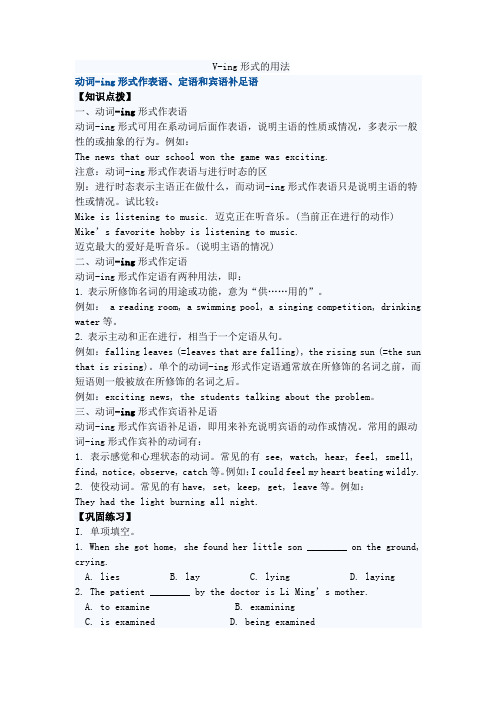
V-ing形式的用法动词-ing形式作表语、定语和宾语补足语【知识点拨】一、动词-ing形式作表语动词-ing形式可用在系动词后面作表语,说明主语的性质或情况,多表示一般性的或抽象的行为。
例如:The news that our school won the game was exciting.注意:动词-ing形式作表语与进行时态的区别:进行时态表示主语正在做什么,而动词-ing形式作表语只是说明主语的特性或情况。
试比较:Mike is listening to music. 迈克正在听音乐。
(当前正在进行的动作) Mike’s favorite hobby is listening to music.迈克最大的爱好是听音乐。
(说明主语的情况)二、动词-ing形式作定语动词-ing形式作定语有两种用法,即:1.表示所修饰名词的用途或功能,意为“供……用的”。
例如: a reading room, a swimming pool, a singing competition, drinking water等。
2.表示主动和正在进行,相当于一个定语从句。
例如:falling leaves (=leaves that are falling), the rising sun (=the sun that is rising)。
单个的动词-ing形式作定语通常放在所修饰的名词之前,而短语则一般被放在所修饰的名词之后。
例如:exciting news, the students talking about the problem。
三、动词-ing形式作宾语补足语动词-ing形式作宾语补足语,即用来补充说明宾语的动作或情况。
常用的跟动词-ing形式作宾补的动词有:1. 表示感觉和心理状态的动词。
常见的有 see, watch, hear, feel, smell, find, notice, observe, catch等。
V-ing形式的用法

V-ing形式的用法V-ing形式分为动名词和现在分词。
现在分词(Present Participle)是分词的一种,分词又分为V-ing形式和过去分词,它们都是非限定动词,即在句子里面不能单独充当谓语,但能充当其它的一些成分(定语,表语,补语和状语),并且它们具有动词的性质。
一:V-ing形式的三个基本特点:1.在时间上表示动作正在进行。
例如:a developing country. 一个发展中的国家,boiling water 沸水,rising sun 冉冉升起的太阳。
(试比较:a developed country 一个发达国家,boiled water 白开水,risen sun 升起的太阳)2. 在语态上表示主动。
例如:the ruling class 统治阶级,the exploiting class 剥削阶级。
(试比较:the ruled class 被统治阶级,the exploited class 被剥削阶级)3. 在含义上表示“令人……”;表示习惯性、抽象性;表示种类、用途。
二:时态与语态主动被动一般式doing Being done完成式having done Having been done三:否定式:所有否定式都是在-ing前面加not1)V-ing形式的时态:V-ing形式本身不能表示具体的时间概念,其动作发生的时间只能是相对于谓语动作发生时间相对而言的。
这一点和不定式用法相同。
A)V-ing形式的一般式:doing表示分词的动作和谓语动作同时或几乎同时发生。
或是谓语动作发生时,分词的动作正在发生过程中。
如:Looking back, I found she was washing clothes.She smelt something burning.(smelt发生在burning的过程中。
) 她闻到有东西烧焦了。
She sat on the chair, reading a novel.B)V-ing形式的完成式:having done表示V-ing形式的动作发生在谓语动作之前。
V-ing形式(短语)用法

V-ing形式(短语)做状语
She sat at the desk reading a newspaper. Being ill, she went home. Having finished their work, they had a rest. Feeling tired, she went to bed early.
problem.
V-ing形式(短语)做宾语
He finished reading the book yesterday. I enjoy learning English. I’m looking forward to seeing you again. She suggested doing it in a different way.
V-ing形式(短语)做主语
Telling a lie got him into a great deal of trouble. Surfing is a popular sport along coastal areas. Seeing is believing. It is no use complaining—it doesn’t help solve the
V-ing形式(短语)做宾补
We heard her singsing in her room. You can see them performing every night this week
at the new theatre. We watch the children diving into the water from the
英语语法.v-ing作状语
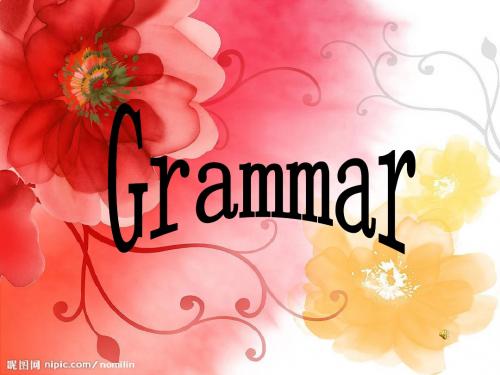
I stood by the door ,but I said nothing.
v-ing做伴随状语,用来说明 动作发生背景或情况。一般情 况v-ing与谓语动词表示动作 同时发生。可以转化为并列句。
She fell off the bike,breaking her left leg.
She fell off the bike,and she broke her left leg.
Having failed many times ,he never gives up. Though he failed many times ,he never gives up.
v-ing做让步状语,相当于状 语从句,v-ing前可带连词 although,even if ,though。
I stood by the door ,saying nothing.
Having finished my homework,I went for a walk.
2.语法性:v-ing主动还是被动,取决于v-ing与句子主语间关系。主要体现 在完成时。
eg:Having been told
the
news,he was surprised.
was happy.
Having eaten an orange ,he
v-ing做结果状语表示必然结 果,通常放语动词动作同时发生,用一般式(doing);若v-ing 动作先于谓语动词动作发生,用完成时(having done)。 eg:Playing in the park ,I met my friend.
v-ing 做原因状语,相当于原 因状语从句,它们也可以相互 转化。
Working hard at be successful.
v-ing形式作状语
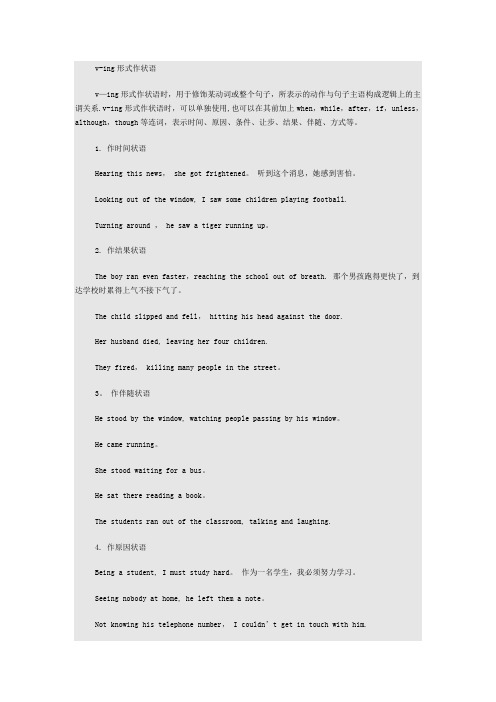
v-ing形式作状语v—ing形式作状语时,用于修饰某动词或整个句子,所表示的动作与句子主语构成逻辑上的主谓关系.v-ing形式作状语时,可以单独使用,也可以在其前加上when,while,after,if,unless,although,though等连词,表示时间、原因、条件、让步、结果、伴随、方式等。
1. 作时间状语Hearing this news, she got frightened。
听到这个消息,她感到害怕。
Looking out of the window, I saw some children playing football.Turning around , he saw a tiger running up。
2. 作结果状语The boy ran even faster,reaching the school out of breath. 那个男孩跑得更快了,到达学校时累得上气不接下气了。
The child slipped and fell, hitting his head against the door.Her husband died, leaving her four children.They fired, killing many people in the street。
3。
作伴随状语He stood by the window, watching people passing by his window。
He came running。
She stood waiting for a bus。
He sat there reading a book。
The students ran out of the classroom, talking and laughing.4. 作原因状语Being a student, I must study hard。
作为一名学生,我必须努力学习。
v-ing的用法(状语)
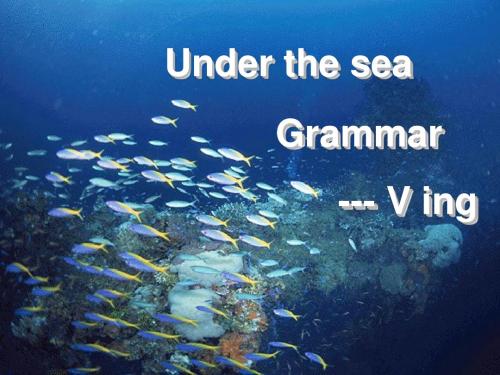
To see is to believe. = Seeing is believing.
3). It’s no use (good) doing sth It’s a waste of time doing sth it 作形式主语, 只用V-ing,不用不定式。
※ It is + adj. + (for sb ) to do sth
宾语。
4. 作定语 *The girl standing there is my sister . *This is a piece of surprising (surprise) __________ being discussed *The problem____________ (discuss) now is very important. working * The farmers ____________ (work) in the fields are tired . news .
5. ___ many times, the boy still didn’t know how to do the exercises. A. Having taught B. B Having been taught C. taught
D. Teaching
6. _________ the whole story, Jane decided not to see the film. A. Having been told A B. Having told C. Been told
2. 作表语 ☆ Teaching is learning. 教学相长. making ☆ My hobby is __________ (make) model planes. ☆ What worried the child most was not being allowed _________ (not, allow) to visit his mother in the hospital .
V-ing作主语和宾语等等

他的爱好是收集邮票。
The problem is quite puzzling.
这个问题很令人困惑。
三、动词-ing形式作宾语
1、作动词的宾语。
(常接动词 -ing 形式作宾语的动词可用下面的口诀帮助 记忆:)
② -ing 分词短语作定语应放在被修饰词的后面,也 相当于一个定语从句。如:
Who is the comrade standing by the door? 站在门边的同志是谁?
They lived in a house facing south. = They lived in a house that faces the street.
He insisted on doing it in his own way. 他坚持要按照自己的方法做。 He went to London in the hope of being a famous painter.
他去了伦敦,希望能成为一个著名的画家。
四、-ing分词作定语:
①单个的分词作定语一般放在被修饰词的前面。如: reading room 阅览室 swimming pool 游泳池 singing competition 歌咏比赛 waiting room 候车室 a sleeping child一个酣睡的孩子 the exciting news令人振奋的消息 a boring speech令人乏味的演出
2. 能用-ing形式作宾语补足语的几类动词:
1) 表示感觉和心理状态的动词,常见的有see, hear, feel, smell, find, notice, observe, look at, listen to等。如: We saw a light burning in the window. I felt somebody patting me on the shoulder. 2) 表示指使意义的动词,常见的有have, set, keep, get, catch, leave等。如: I won’t have you doing that. This set me thinking. I’m sorry to have kept you waiting.
动词ing作定语和状语
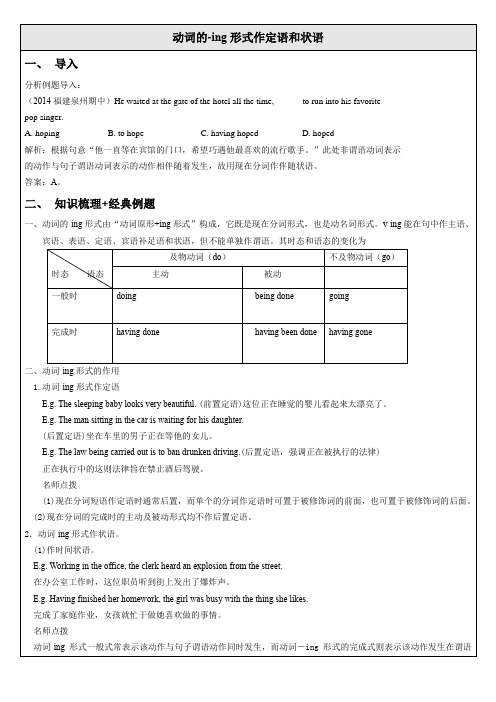
动作之前。
(2)作原因状语。
E.g. Lacking enough money, they had to give up the plan.由于缺乏足够的资金,他们只好放弃了这项计划。
(3)作条件状语。
E.g. Getting the chance to study abroad, he will try his best to improve himself.如果得到到国外学习的机会,他将尽力提升自己。
(4)作结果状语。
E.g. He failed to work out the last question in the math paper, making him lose the chance to enter his ideal university.他没有能够做出数学试卷上的最后一道题,致使他失去了上理想大学的机会。
(5)作让步状语。
E.g. Working hard all the day, he still felt energetic.尽管努力工作了一整天,他仍然感到精力充沛。
(6)作伴随状语。
E.g. The girls sat together in front of the house, talking and laughing.女孩们一起坐在屋前,又说又笑。
(7)作方式状语。
E.g. They greeted each other bowing to each other.他们鞠躬彼此打招呼。
名师点拨(1)动词-ing形式作状语时相当于与之对应的状语从句,并且可互相转换。
(2)动词-ing形式作伴随状语时,则可转化成并列谓语。
E.g. Knowing what to do next, he set out to do it at once.=When he knew what to do next, he set out to do it at once.当明白下一步要做什么时,他立刻开始着手做起来。
V-ing-详解
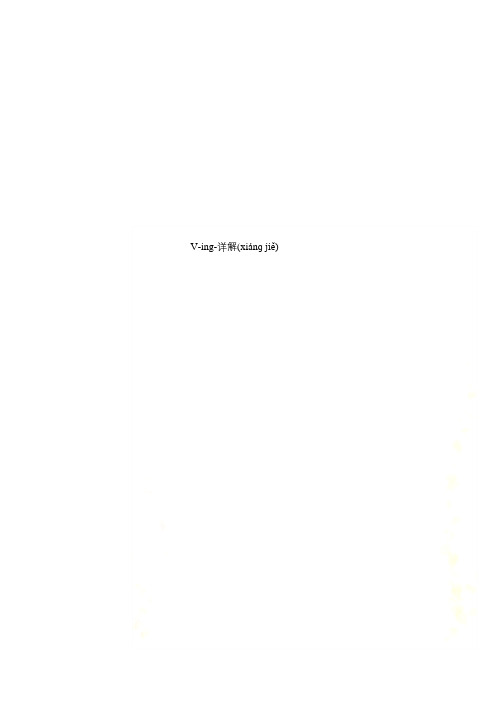
V-ing-详解(xiánɡ jiě)V-ing-详解(xiánɡ jiě)必修四 Unit 2---Unit 4 语法(yǔfǎ)详解动名词和现在(xiànzài)分词用法解析一、V-ing 形式(xíngshì)概念(1) V-ing 形式(xíngshì)包括两种:①动名词:具有名词特征,在句子中可作主语(zhǔyǔ),宾语,表语,定语等。
②现在分词: 具有形容词和副词特征,在句子中可作定语、状语、表语、宾补Speaking in the public , he will surely be very cheerful .(现在分词短语,作状语)他在公众场所讲话时总是兴高采烈的。
She hates speaking in the public. (动名词短语,作宾语)她不喜欢在公众场所讲话。
Feeling the lesson boring, the students are sleepy. There are many sleeping students in class.Seeing is believing.I suggest going shopping tomorrow.The lesson is boring.第3页/共30页第4页/共30页(2) 动词ing 时态及否定(fǒudìng)形式① V-ing 一般式表示这个动作正在进行(jìnxíng)或与谓语表示的动作同时发生.Eg: They went out of the classroom, talking andlaughingThe large building being built isa library. ② Ving 完成式: 强调(qiáng diào)这个的动作在谓语动词所表示的动作之前完成Eg: Having lived in this city for three years, sheknows it very well. 时态态语态主动形式被动形式 一般式(not) doing(not) being done 完成式 (not )having done (not) having been doneEg: Having been shown the lab, we were taken to see the library.动词ing的否定形式(xíngshì)在ing的前面加not 或never的否定副词Not knowing how to find the subway, I asked a policeman for help.Never have been to Beijjing before, she felt at a loss where to go.二、动名词详解(xiánɡ jiě)(1)动名词作主语(zhǔyǔ)Reading French is easier than speaking it. 阅读(yuèdú)法文比讲法语容易。
非谓语动词句法作用详解
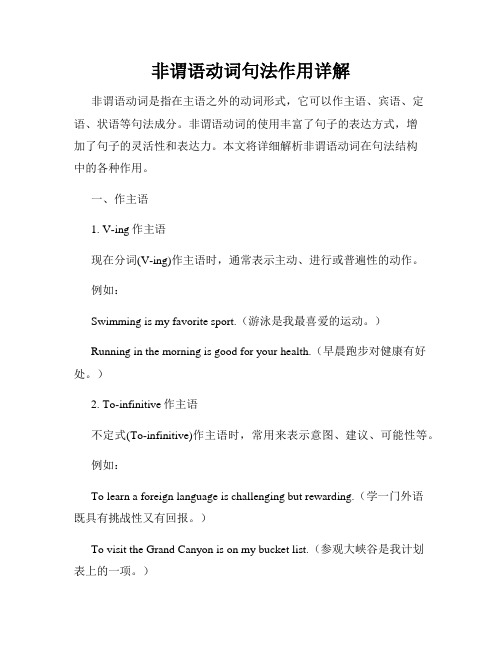
非谓语动词句法作用详解非谓语动词是指在主语之外的动词形式,它可以作主语、宾语、定语、状语等句法成分。
非谓语动词的使用丰富了句子的表达方式,增加了句子的灵活性和表达力。
本文将详细解析非谓语动词在句法结构中的各种作用。
一、作主语1. V-ing作主语现在分词(V-ing)作主语时,通常表示主动、进行或普遍性的动作。
例如:Swimming is my favorite sport.(游泳是我最喜爱的运动。
)Running in the morning is good for your health.(早晨跑步对健康有好处。
)2. To-infinitive作主语不定式(To-infinitive)作主语时,常用来表示意图、建议、可能性等。
例如:To learn a foreign language is challenging but rewarding.(学一门外语既具有挑战性又有回报。
)To visit the Grand Canyon is on my bucket list.(参观大峡谷是我计划表上的一项。
)二、作定语1. V-ing作定语现在分词(V-ing)作定语时,常用来修饰名词,表示被修饰名词的用途、功能、来源等。
例如:The running water is so refreshing.(流动的水非常清爽。
)A sleeping baby needs to be treated gently.(熟睡的婴儿需要温柔对待。
)2. 过去分词作定语过去分词作定语时,通常用来修饰被动或完成的状态、感受等。
例如:The broken window needs to be fixed.(这个破窗户需要修理。
)The lost key was found under the bed.(丢失的钥匙在床底下找到了。
)三、作宾语1. 不定式作宾语不定式(To-infinitive)作宾语时,常用来表示目的、打算、习惯等。
v-ing作定语和状语

5、作条件状语
• Working harder, you will succeed. • (=If you work harder, you will succeed.)
我们到达长春时是午夜。
We arriving in chuangchun ______________________, it was midnight.
独立成分作状语
有些分词作状语时,起形式的选用不收上下文的影响,称作独立成分或插 入语。常见的有:
generally / frankly/ strictly speaking 一般而言/坦率地说/ 严格地说 judging from /by 根据…来判断 considering / taking …into consideration考虑到…;鉴于…
动词-ing 形式作条件状语,相当于一个条件状语从句。
• 一直往前走,你就会看到一座白色的房子。
• Walking ahead, you will see a white house. • Keeping on trying, you will realize your dream.
Keep on trying, and you will realize your dream.
练习: 1. Many students _____ around, I explained the story into details.(07 重庆) A. stood B. standing C. to stand D. were standing 2.There ___ nothing to talk about , every one in the room remained silent . A. was B. had C. being D. having
ving形式作状语

=Because he was so angry, he couldn’t go to sleep. 因为太生气了,他不能入睡。
Having been to the Great Wall many times, he didn’t go last week. =Because (As) he had been to the Great Wall many times, he didn’t go last week. 因为他已经去过长城许多次,上 周他就没去。
1. 作时间状语 -ing短语作时间状语要置于句首。如: Hearing the bad news, they couldn’t
help crying.
=When they heard the bad news, they couldn’t help crying. 当听到这个不幸的消息时,他们情不自 禁地哭了起来。
3. 作条件状语 -ing作条件状语置于句首或句末。如: Working hard, you will succeed. =If you work hard, you will succeed. 如果你勤奋一点,你就会成功。 Being given more attention, the trees could have grown better.
area looking around curiously. attributive
2. I stood for a minute watching them and went
to greet them.
adverbial
adverbial
3. She stepped back appearing surprised …
-ing形式短语作定语时一般放在它 所修饰的名词之后, 相当于一个定语从 句。 e.g. 1.They are visitors (who are) coming from several countries.
专题05 重点语法复习:V-ing 作定语、状语和宾补(考点串讲+模拟演练)高一英语下学期(解析版)

专题05重点语法复习:V-ing作定语、状语和宾补▲动词-ing形式作定语1.单个的动词-ing形式可以作前置定语,一般具有两种含义。
(1)说明被修饰名词的用途和性能。
a reading room=a room for reading阅览室running shoes=shoes for running跑鞋(2)表示所修饰的人或物的动作或状态,在意思上接近一个定语从句,可以表示正在进行的动作,也可表示经常性动作或当时的状态。
developing countries=countries that are developing发展中国家a sleeping baby=a baby who is sleeping正在睡觉的婴儿2.作定语的动词-ing形式如果是一个短语,则应放在被修饰词的后面,作后置定语,相当于一个定语从句。
There is a path leading to the top of the hill.→There is a path which leads to the top of the hill有一条通向山顶的小路。
Do you know the boy playing basketball?→Do you know the boy who is playing basketball?你认识在打篮球的那个男孩吗?▲动词-ing形式作状语动词-ing形式可以作状语,在句中表示时间、原因、结果、条件、让步、行为方式或伴随情况等。
动词-ing形式作时间、原因、条件、让步状语时多位于句首;作结果、伴随状语时常位于句末。
1.表示时间,相当于一个时间状语从句。
Having delivered the milk to the customer’s house,he went home for breakfast.→After he delivered the milk to the customer’s house,he went home for breakfast.把牛奶送到顾客家后,他就回家吃早餐了。
- 1、下载文档前请自行甄别文档内容的完整性,平台不提供额外的编辑、内容补充、找答案等附加服务。
- 2、"仅部分预览"的文档,不可在线预览部分如存在完整性等问题,可反馈申请退款(可完整预览的文档不适用该条件!)。
- 3、如文档侵犯您的权益,请联系客服反馈,我们会尽快为您处理(人工客服工作时间:9:00-18:30)。
V-ing作定语和状语Ⅰ. V-ing 作定语单个的V-ing作定语,常放在被修饰的名词前面作前置定语;V-ing短语作定语,则放在被修饰名词的后面,作后置定语。
1.V-ing作定语,说明被修饰词的性质、特征或用途。
He may be in the reading room . (read) 他可能在阅览室里。
They set up an _______________ table. (operate) 他们搭起一个手术台。
2.V-ing 作定语,表示其与被修饰词之间为主动关系,并且表示动作正在进行。
There are about 200 students studying in this school. 大约有200个学生在这个学校学习。
Who is the woman_________________our English teacher?( talk) 正在和我们英语老师谈话的那个女人是谁?3.有些V-ing已经转化成了形容词,常用作定语修饰物,表示“令人……”:exciting, shocking, puzzling, confusing, disappointing, discouraging, boring, tiring, moving, touching, interesting, satisfying, frightening, amazing等。
①That must be a ______________experience. (terrify) 那肯定是一次可怕的经历。
②The experiment was____________________________. (amaze) 那实验是一个惊人的成功。
Ⅱ. V-ing作状语V-ing (短语)可以在句子中作状语来修饰谓语动词或整个句子,表示动作发生的时间、原因、条件、结果、方式、让步或伴随状况。
现在分词一般不用作表目的的状语(通常用不定式表目的状语)。
V-ing作状语,其逻辑主语必须与句子的主语________,且分词必须和句中的主语是逻辑上的__________关系。
1. 作时间状语_________________________, he jumped with joy.(hear) 当听到这个好消息时,他高兴地跳了起来。
2. 作结果状语The boy ran even faster,reaching the school out of breath. 那个男孩跑得更快了,到达学校时累得上气不接下气了。
The song is sung all over the country, ________________________ song.( make) 全国到处在传唱这首歌曲,使它成了一首最受欢迎的歌曲。
3. 作伴随状语与谓语所表示的动作同时发生。
He stood by the window, watching people passing by his window.他站在窗前,望着来来往往的人们。
_____________________, they went into the room .( talk) 他们有说有笑地走进房间。
4. 作原因状语Being a student, I must study hard. 作为一名学生,我必须努力学习。
___________________, he didn‟t go to school.(be) 由于生病,他没有上学。
注意:表示原因的V-ing 形式一般位于句首,相当于一个原因状语从句。
其否定式直接在句首加not . ______________________her address, , we couldn‟t get in touch with her. ( know) 由于不知道她地址,我们无法和她联系。
5. 作让步状语Being young,the little boy knows a lot about computer.尽管这个小男孩很小,但是他懂得很多电脑知识。
_________________ here for four years, I am not familiar with my neighbors. (live)虽然我在这儿住了四年,我对邻居们都还不熟悉。
6. 作条件状语Heating water, we can change it into vapor. 把水加热,我们可以将其变为水蒸汽。
_____________ahead, you will see a white house.( walk) 一直往前走,你就会看到一座白色的房子。
7. 作方式状语____________________, we visited many places. (travel) 我们乘车游览了许多地方。
注意:1.当v-ing所表示的动作发生在谓语动词之前时,应使用__________式:_________________①After he finished his homework, he rushed out to play basketball.=___________________his homework, he rushed out to play basketball.他完成作业后冲出去打篮球。
②After he closed the windows, he went out of the classroom.=____________________the windows, he went out of the classroom. 关上窗户后,他走出教室。
2.当v-ing与句子的主语之间存在着逻辑上的动宾关系时,应该使用________式:_________.The tall building ___________________ now is our new school.( build) 正在被修建的那栋大楼是我们的新学校。
3. V-ing作状语时,它的逻辑主语必须与句子的主语_______________。
①Rushing into the dining-room, I found super was waiting for. ()②Rushing into the dining-room, supper was waiting for me. ()Ⅲ. 连词+ V-ingV-ing作状语时,相当于省略的状语从句。
由when / while / after / before / if /though / unless/as if等引导的状语从句的主语与主句的主语一致时,如果从句的谓语动词是主动语态,则可以省略从句的主语,而保留原连词,形成"连词+现在分词"的结构形式。
1.Though they lacked(缺少)money, his parents managed to send him to university.=______________________ money, his parents managed to send him to university.2.When I was walking in the street, I came across an old friend of mine.=_____________________________, I came across an old friend of mine.3.Unless I was invited, I wouldn‟t go to the party.=_____________________, I wouldn‟t go to the party.4.As I am a student, I must study hard.= _________________a student, I must study hard.Ⅳ. 独立主格结构1.V-ing作状语时,V-ing的逻辑主语必须与句子的主语保持____________。
当V-ing逻辑主语与句子的主语__________,而带有自己逻辑主语时,这样的结构叫______________结构。
表示伴随,时间、原因、条件等。
①____________________________, they decided to put the meeting off.(absent)由于许多人都缺席了,他们决定取消这次会议。
②Many students________________________, I explained the story into details.( stand) 我详细地解释这个故事,周围站着许多学生。
③_______________________, we will pay a visit to the whole city. (permit)时间允许的话,我们将参观整座城市。
④_________________________, we had to stay at home.( rain)由于天下大雨,所以我们不得不呆在家里。
2.有些分词作状语时,其形式的选用不受上下文的影响,称作独立成分或插入语。
常见的有:generally / frankly/ strictly speaking 一般而言/坦率地说/ 严格地说judging from /by 根据…来判断taking …into consideration /considering考虑到…;鉴于…supposing / providing /provided that 如果compared with 与…相比①_________________________ , you …d better have a rest .( Consider) 鉴于你的健康,你最好休息。
②_________________________ , he is from the south . (judge) 从他的口音判断,他来自于南方。
③_________________________, his answer is right . (speak) 一般来说,他的答案是对的。
Ⅴ.Practice:1. It‟s a pleasure to watch the face of a _______ baby.(sleep) 看着睡着的婴儿的脸是一件愉快的事。
2. _______________________, I still think she hasn't tried her best. (admit) 尽管承认她所说的话,但我仍然认为她没有尽到最大的努力。
